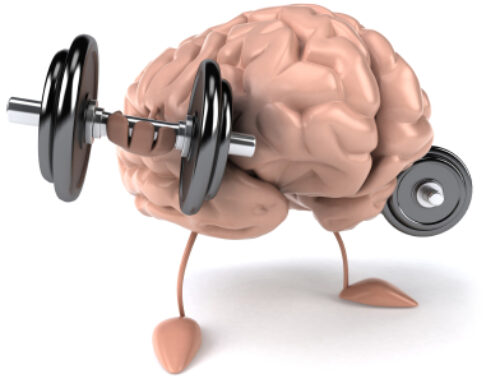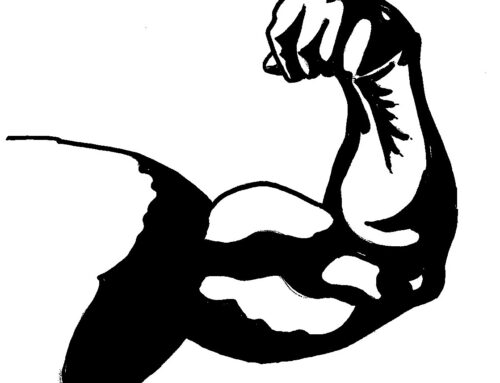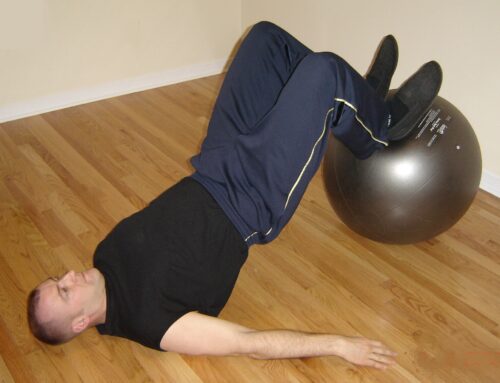Why the Biggest Losers Regained The Weight
A few weeks ago there was a “Biggest Loser Study” that was getting a lot of media attention. It basically showed that 6 years later the majority of the contestants on the show had regained most of their weight. Even worse, it also revealed that their metabolism was slower than it was previously. For more details check out the Research Review of this study on the Precision Nutrition site at www.precisionnutrition.com/the-biggest-loser-study.
The unfortunate thing is that this study paints a dismal picture that it’s impossible to sustain fat loss over the long term. Of course, the mainstream media loves these types of stories and they jumped all over it. However, that conclusion is absolutely false. The Biggest Loser Study failed to fully explain why these individuals regained most of the weight. We need to ask the question: “What mistakes are they making on the Biggest Loser program that is contributing to this problem?” I’ll get to that later in this article.
First of all, let’s look at how your body adapts when you lose weight. While you do need to be in a caloric deficit for weight loss to occur, the fact is that whenever you reduce your caloric intake and lose weight there will be a downgrade in metabolic activity. In order to lose fat, there also has to be metabolic adaptation. Your body will try to restore metabolic homeostasis (balance) and prevent further weight loss by several mechanisms (ie: altering hormones and energy expenditure). It’s unavoidable.
Many people call this Metabolic “Damage” or “Starvation Mode”, however those terms are misleading. Except in very extreme (and rare) examples, you are not ‘starving’ or ‘damaging’ yourself… you’re body is just naturally adapting. Metabolic Adaptation is a more appropriate description. The key is to understand what to do about it!
What Is Metabolic Adaptation?
Your metabolism is simply the chemical processes occurring inside you to keep you alive. Most of your Total Energy Expenditure (TEE) / metabolic activity is involved with basic needs of living while at rest (ie: breathing and circulation, etc) and is referred to as your Basal Metabolic Rate (BMR) or Resting Metabolic Rate (RMR). These both have slightly different definitions, but basically that’s your “non-active” metabolism.
Then there is the Thermic Effect of Activity (TEA), which involves exercise, walking, working, regular daily activities, etc. There is also a more adaptive component of metabolic rate called Non-Exercise Activity Thermogenesis (NEAT). NEAT relates to unconscious changes in physical activity such as fidgeting, moving around, how quickly you move, and basically other spontaneous movements that burn calories without really accomplishing much. Remember that skinny in kid back in school who couldn’t sit still and was always fidgeting his hands or bouncing his leg? He was actually burning A LOT more calories over the course of a day than you might expect. NEAT can account for 200-900 calories/day of caloric expenditure!
Finally there is the Thermic Effect of Food (TEF), which refers to the energy required to process, digest and utilize the nutrients you ingest after eating.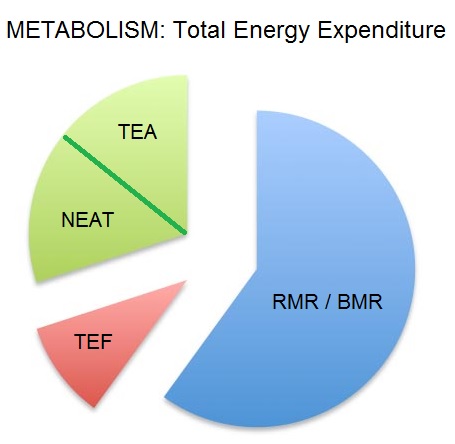
When you reduce your caloric intake and start losing weight, there is obviously a reduced TEF because you are eating less. But another less obvious result of metabolic adaptation is a significant reduction in your NEAT, which you may not even be aware of. You will unconsciously fidget less, move more slowly, sit more, walk less, and exercise with less intensity. In addition, due to certain hormonal changes and possibly a loss of muscle tissue, there is also a reduction of your BMR.
Metabolic Adaptations During a Calorie Deficit:
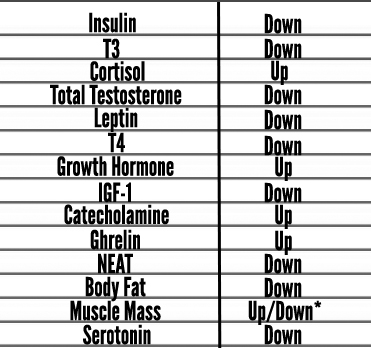
Image Credit – leighpeele.com/starvation-mode
*Loss or gain of muscle tissue depends on your participation in a resistance training program.
How to Mitigate the Negative Effects of Metabolic Adaptation
(DURING a Diet / Fat Loss Program)
Now you should have a better understanding of what metabolic adaptation is and how it can make it difficult for you to keep the weight off once you lose it. So what can you do about it? I’m going to share some suggestions for how to reduce some of these negative adaptations while you’re in a caloric deficit during a fat loss program. I’ll also explain how this relates to some of the mistakes made on the Biggest Loser program (or at least some things they could have done better).
- Focus more on resistance training and less on cardiovascular exercise. Progressive Resistance Training can help reduce the loss of muscle tissue while you are losing fat. Maintaining muscle helps to maintain a higher metabolism as well as support a healthy hormonal balance (reduces some of the negative hormonal adaptations such as reduced testosterone, growth hormone, and insulin sensitivity).
- Focus more on HIIT instead of LISS cardio. If you are going to use cardiovascular exercise to burn more calories, use High Intensity Interval Training (short, intense workouts alternating fast/slow intervals) more than traditional Low Intensity Steady State cardio. LISS cardio can actually increase the negative hormonal adapations (ie: increased cortisol, decreased T3).
- Pay attention to your macronutrients (protein, fats, carbs). Aim to consume enough protein (about 1 gram per pound of “lean body weight” daily), sufficient essential fats, and slightly higher carbohydrate intake around your workouts. Again, this can help you maintain muscle, metabolism, and a favorable hormonal balance.
- Take regular ‘breaks’ from your calorie deficit diet by including “Refeeds”. This may be one of the most powerful methods for preventing long term negative metabolic adaptations! Schedule a ‘refeed’ day every week or two, where you take a break from your calorie deficit and eat at maintenance calories. It’s also important to take a longer ‘refeed break’ if you’ve been in a deficit for a longer period of time. For example, after two to three months in a deficit, schedule one or two refeed weeks during which you will eat at maintenance calories for 7 to 14 days, before going back to your caloric deficit.
- Keep in mind that because your metabolism is slower, your maintenance calories will be lower than before you started your diet, so you need to adjust for that. That’s why keeping a nutrition journal using a free app like My Fitness Pal is so helpful.
- The goal of the refeed period is to increase calories (especially from carbohydrates) in order to offset the negative metabolic adaptations, without “overeating” or gaining excess body fat.
- Sometimes people refer to these “refeed days” as “Cheat Days”, which in my opinion is less appropriate and carries a negative association. However, I did write an article on How to Manage Your Cheat Meals, in which I included several videos of my own “extreme” cheat meals. There is some solid information there, but keep in mind these videos are primarily for entertainment purposes… don’t try this at home!
=> Manage Your Refeed Days (Crazy “Cheat Meal” Videos!)
Biggest Loser Mistakes:
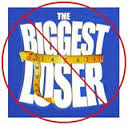 After reviewing the Four Key Points listed above, it should become clear that on the Biggest Loser show they failed to appropriately implement ANY of those strategies. The Biggest Losers focused primarily on cardiovascular exercise (and LOTS of it!) rather than resistance training. As a result, the participants lost a LOT of muscle mass along with the fat loss, which contributed to their lowered metabolic rates.
After reviewing the Four Key Points listed above, it should become clear that on the Biggest Loser show they failed to appropriately implement ANY of those strategies. The Biggest Losers focused primarily on cardiovascular exercise (and LOTS of it!) rather than resistance training. As a result, the participants lost a LOT of muscle mass along with the fat loss, which contributed to their lowered metabolic rates.
They also implemented a very extreme caloric deficit while introducing a massive increase in physical activity. Unfortunately, there were NO scheduled refeed periods … they were kept on a very low calorie diet for an extended period of time without planned breaks. It’s also very unlikely that these people were meeting even minimal macronutrient needs. All of this resulted in leaving the participants with a crappy metabolism when they were finished their season.
Long Term Fat Loss IS Possible!
 Now you should understand what to do DURING a fat loss diet to avoid those metabolic pitfalls. But what about AFTER you lose the weight… how can you keep it off? This is where many people get lost and end up regaining most of the fat they lost. This is also another area where the Biggest Loser program messed up big time … their follow-up plan sucked.
Now you should understand what to do DURING a fat loss diet to avoid those metabolic pitfalls. But what about AFTER you lose the weight… how can you keep it off? This is where many people get lost and end up regaining most of the fat they lost. This is also another area where the Biggest Loser program messed up big time … their follow-up plan sucked.
Many people believe that the only way to prevent rebound weight gain is to maintain a caloric deficit forever and / or do even more cardio to keep the fat off. Of course this is unsustainable which is why some people just give up.
However, there is a way to keep most of the fat off while up-regulating your metabolism after your diet. The main thing is to follow the strategies I listed above WHILE you are losing the fat in the first place. When you reach your goal, or decide to give the diet a break, it’s time to quit the “refeed days” and introduce the following instead:
- Reverse Dieting is simply the concept of gradually increasing your caloric intake over a period of several weeks, rather than just stopping your diet and immediately jumping back to your previous maintenance calories. Let’s say your maintenance calories were around 2800 calories before you started your diet, and you finished your diet in a deficit at about 2000 calories. You wouldn’t want to immediately ramp right back up to 2800 calories. You’d start gaining fat quite quickly. That’s where the progressive Reverse Diet comes in.
Remember that due to metabolic adaptation, your maintenance calories are now lower then before, so you need to slowly increase your calories week by week to give your metabolism time to increase. This also helps you assess what your new, lower maintenance calorie needs are. Gradually increase your caloric intake by about 100 calories a day each week, and keep track of your body weight and waist measurement (at the belly button) at the end of each week to monitor whether you’ve gained body fat and adjust calories accordingly.
Even with reverse dieting you can expect to gain a little body fat, but if you continue to focus on progressive resistance training, keep your protein intake constant (around 1 gram per lb of LEAN body weight daily) and consume enough carbs around your workouts, you will also be gaining more lean muscle tissue while ramping up your metabolic rate. (You can also learn more about alternatives to reverse dieting in this article: Alternatives to Reverse Dieting) - Follow a progressive resistance training program focused on building muscle! I can’t emphasize this enough – you need to focus your exercise program on strength training, train with intensity, and progress regularly (manipulating either load, reps, sets, tempo, rest intervals, or exercise variations) with the goal of gaining muscle tissue.
- Gradually increase your carbohydrate intake. Yes that’s right, I said “increase” your carbs! Increasing your carbohydrates will help you build muscle, support insulin sensitivity, improve your hormonal profile, increase satiety, improve your energy and mood, and increase the overall TEF (thermic effect of food). Start by increasing your carbs on your training days, particularly around your workouts.
- Improve your insulin sensitivity. Related to increasing your carb intake you also want to improve your insulin sensitivity so that you can process those carbs effectively. Here are some strategies for improving insulin sensitivity:
- Perform resistance training exercise before your high carb meals.
- Get enough quality sleep.
- Experiment with Intermittent Fasting a couple of days per week. Learn more here: Benefits of Intermittent Fasting.
- Take supplements such as EGCG (green tea extract), Alpha Lipoic Acid (ALA), Cinnamon, Ginseng, and Magnesium with your carbohydrate meals.
- Take caffeine before your workouts. This will increase your energy (so you can train harder) and increase thermogenesis (heat production and increased calorie expenditure / fat loss).
- Make smart food choices. Now that you’re no longer in a caloric deficit the quality of the food you eat becomes even more important. Choose less processed foods that are nutrient dense as well as satisfying. Just because you are starting to consume more calories doesn’t mean it’s time to binge on massive amounts of “junk food”. Enjoy a ‘treat’ every now and then (if it fits your calorie and macro needs) but focus on healthy food choices. Check out my article on the Top 5 Priorities of Fat Loss Nutrition for more info: Fat Loss Diet Priorities.
Finally, you need to work on your MINDSET. Remind yourself that you CAN do this! You WILL reach your goals! Get motivated, keep focused, and stay dedicated. Now you know how to lose the weight AND keep it off. Remember, long term results don’t require long term starvation diets.




